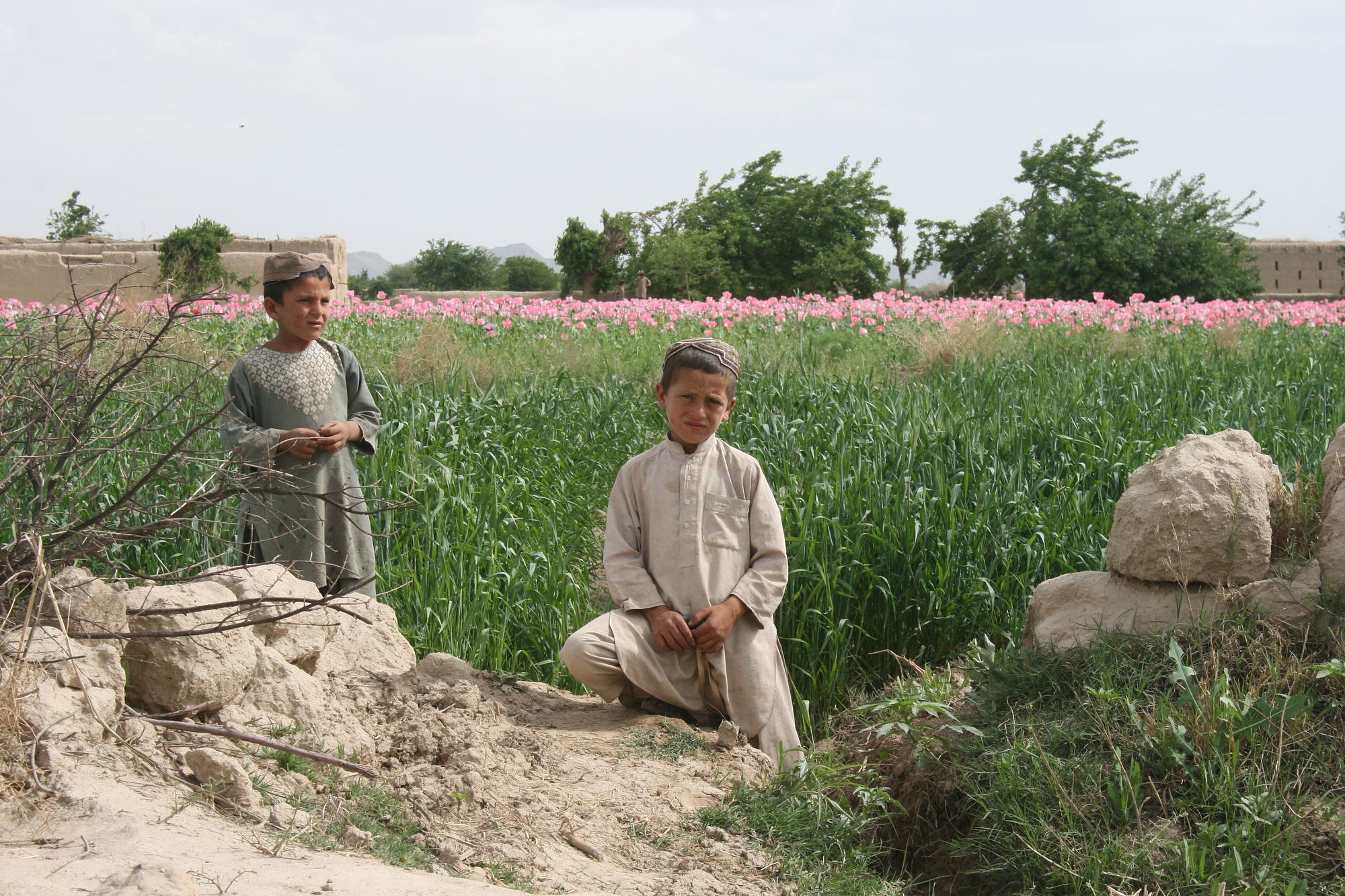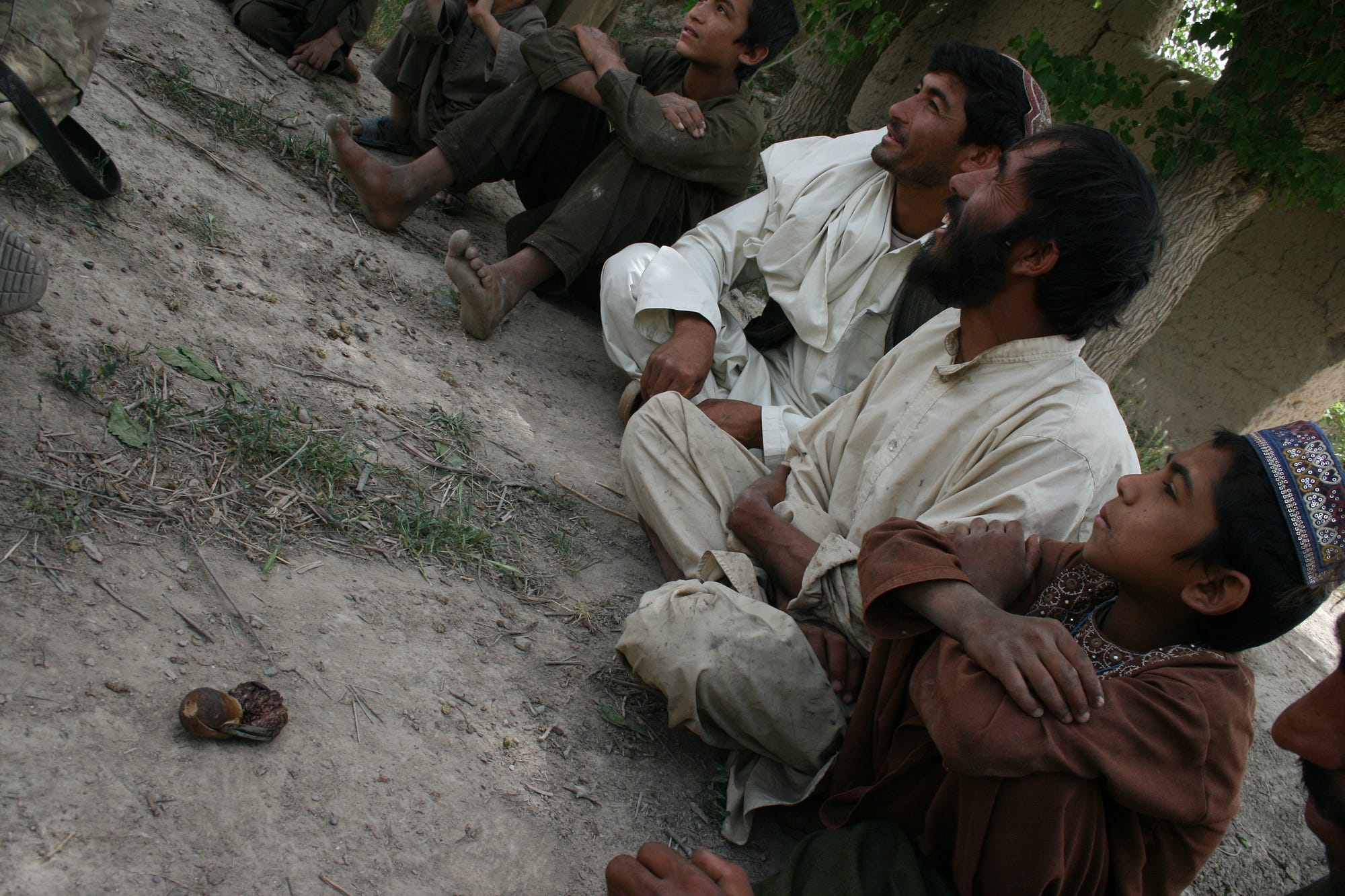The U.S. military learned the hard way not to interfere with Afghanistan’s thriving production of poppies, the colorful flowers that are the source of opium and, by extension, heroin.
Now we know the cost of that lesson—a cool $7.6 billion.
On Oct. 14, the U.S. Special Inspector General for Afghanistan Reconstruction—a.k.a., SIGAR—alerted the Defense, State and Justice Departments to this latest dollar figure for poppy-elimination efforts.
 And here’s SIGAR’s kicker. Despite the nearly $8 billion America has spent on eradication efforts, today the Afghan opium trade is booming. At 400,000 acres, the poppy crop in 2013 was the biggest ever.
And here’s SIGAR’s kicker. Despite the nearly $8 billion America has spent on eradication efforts, today the Afghan opium trade is booming. At 400,000 acres, the poppy crop in 2013 was the biggest ever.
Above—poppies in southern Afghanistan. David Axe photo. At top—U.S. Marines, Afghan troops and civilians in a poppy field. NATO ISAF photo
One potent flower
Cultivating poppies has been illegal in Afghanistan since 2001, the same year that U.S. and allied troops invaded. But local authorities have enforced the law only sporadically. After all, they benefit from the opium trade, too.
Likewise, for the first three years of the occupation, the U.S. military left the poppy farmers alone.
The Americans were there to fight the Taliban, not to regulate an illicit drug trade or reform the farming habits of a whole society. In the early days of the war, Pentagon planners removed drug-related sites from lists of potential targets.
The State Department and the Drug Enforcement Agency, however, were determined to stamp out the poppies—and pressured the Defense Department to help raid laboratories and bulldoze fields. The State Department and the DEA argued that there was a clear connection between Afghanistan’s black-market opium and the Taliban.
They were right. The insurgents act as middle men in the poppy trade and have funneled millions of dollars in revenue into attacks on the occupation forces and the Afghan government.
To fight terrorism was to fight opium, was the DEA and State Department’s reasoning. Russia and the U.N., both grappling with devastating heroin epidemics, agreed with this assessment. And bowing to pressure, in 2004 U.S. troops began destroying poppy fields.
The eradication process was long, laborious … and pointless.
Afghanistan officials refused to allow aerial spraying of crop-killing poisons. That meant American soldiers had to clear the poppies by hand. They walked through the fields, swatting down the flowers bulb by bulb. Or they ran tractors back and forth across the fields.
The early eradication efforts were too imprecise to eliminate more than a fraction of the poppy crop. But they were destructive enough to alienate thousands of impoverished farmers—the very people the U.S.-led coalition was also trying to win over with expensive development and education projects, all in order to transform Afghanistan into some semblance of a modern country.
Eradication was at best pointless—and at worst dangerously counterproductive.
In 2006, the Americans switched up their tactics. As eradication continued, the military and the State Department also offered farmers alternative crops including wheat and almonds. The DEA flew in Colombian counternarcotic agents to help train their Afghan counterparts. The State Department constructed an $8-million drug court in Kabul.
This new approach failed, too.
 “You look at the indictments, and it looks like a sixth grader wrote it,” Rob Lunnen, a Salt Lake City federal prosecutor who assisted the drug task force in Afghanistan, told The New York Times back in 2007.
“You look at the indictments, and it looks like a sixth grader wrote it,” Rob Lunnen, a Salt Lake City federal prosecutor who assisted the drug task force in Afghanistan, told The New York Times back in 2007.
Afghan poppy farmers and, in front of them, a wad of opium paste. David Axe photo
Driving a wedge
The Taliban began targeting soldiers and civilians working on eradication. Now a pointless strategy was also becoming very, very dangerous. Meanwhile, the colorful poppy flowers flourished amid the chaos.
In 2009, the exasperated American troops finally backed off. The military abandoned counternarcotics operations. But the State Department and DEA continued to woo farmers and train Afghan drug-enforcement agents. The recent record poppy acreage figure is indicative of how successful that’s been.
For many Afghans, poppies represent a chance to escape grinding poverty. They’re a sturdy crop. Low labor. Low risk. High demand. According to a recent report from the U.N. Office on Drugs and Crime, the poppy trade in Afghanistan was worth $3 billion in 2013, up from $2 billion in 2012.
One acre of poppies can bring in upwards of $10,000 a year. It’s hard to argue with a number like that when you’re starving and destitute.
The military knows this. It’s also fully aware that Afghan farmers are a great source of information. They’re out there, day after day, witnessing the comings and goings of Taliban fighters. They can be very useful if they’re willing to talk. They’re not willing to talk when you wreck their fields.
 In recent years, American troops have taken pains to avoid even theperception that they’re destroying poppies.
In recent years, American troops have taken pains to avoid even theperception that they’re destroying poppies.
U.S. Army troops alongside a poppy field in southern Afghanistan. David Axe photo
Our bad
The State Department and the Pentagon both responded to the inspector general’s recent memo about the $7.6-billion price tag on a decade’s worth of eradication efforts.
The State Department was in denial. The military … downright pissy.
“We are making good progress in building the capacity of our Afghan partners to design, lead and manage over the long term strategic and tactical counternarcotics efforts,” Randolph Carter, a program director at the U.S. embassy in Kabul, told SIGAR.
He then explained that the efforts are “works in progress,” and that there’s “no silver bullet to eliminate drug cultivation or production.” Carter admitted that America’s “counternarcotic goals can be accomplished only when these are also Afghan counternarctoic goals.”
But of course, Afghans don’t want to give up poppies—and their leaders aren’t inclined to make them. When it comes to Afghan opium, the State Department is powerless, even if it doesn’t want to come right out and say it.
For its part, the Pentagon came to terms with its own impotence years ago when it halted military eradication efforts. Hence Assistant Secretary of Defense Michael Lumpkin’s curt response to the inspector general’s letter.
“Since [The Pentagon] does not conduct eradication activities in Afghanistan … ,” Lumpkin wrote, “we respectfully request that you remove Secretary [of Defense Chuck] Hagel as an addressee.”
The military knows it helped to blow $8 billion trying, and failing, to eradicate the most important crop in a nation of poor farmers. It doesn’t need reminding.
No comments:
Post a Comment